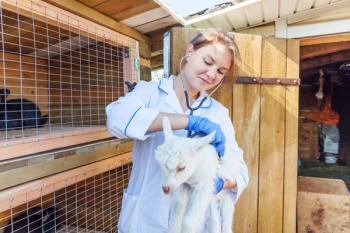
What's Causing Alopecia in Pomeranians?
The exact cause of Alopecia X in Pomeranians remains unknown, but a recent study provided some important genetic clues.
Alopecia is a common canine skin condition. The normal hair growth cycle has 3 main phases: anagen (growth); catagen (regression); and telogen (quiescence); other phases include exogen (hair shedding) and kenogen (empty hair follicles between telogen and anagen).
Follicular epithelial stem cells (SCs) allow for continual epithelial remodeling throughout the hair cycle. The interaction between hair cycle regulation and SC activity is complex and depends on such factors as the dermal microenvironment and molecular signaling pathways like Sonic hedgehog (Shh), bone morphogenic protein (BMP), and Wnt.
Alopecia X (AX) is a hereditary condition that primarily affects Pomeranians and causes truncal alopecia and skin hyperpigmentation. To date, AX’s etiology remains unknown, although altered sex hormone metabolism has been suggested as an underlying cause. A recent
RELATED
- A Genetic Mutation Causes a Rare Skin Disease in Dogs
- New Insight on the Genetic and Neural Basis of Obsessive-Compulsive Disorder
Genetic Analysis
Researchers obtained punch biopsies from the alopecic skin of 5 Pomeranians with AX and haired skin of 4 healthy Pomeranians. Genetic biopsy analyses identified genes and determined gene expression.
AX biopsies revealed hair follicles primarily in telogen or kenogen, suggesting dysfunctional anagen activity. Approximately 1600 genes were identified, with about 570 being upregulated and 1030 being downregulated in the dogs with AX; around 75% of the 1600 genes were involved in either cellular or metabolic processes. Cluster analysis demonstrated separate clusters of alopecic and control samples based on gene expression profiles.
Hair Cycle Regulation
Researchers identified 47 genes responsible for hair cycle regulation. Downregulated genes primarily belonged to the Wnt and Shh pathways, which induce and maintain anagen. For example, the downregulated SHH and SMO genes in the Shh pathway initiate anagen.
Stem Cell Regulation
The Wnt and Shh pathways contained several downregulated genes that normally code for SC markers. A gene that regulates SC quiescence (NFATC1) within the BMP pathway, which inhibits anagen, was upregulated. Future studies are needed to determine whether this downregulation of SC markers indicates specific alopecic conditions or a general response to diseased skin, the researchers noted.
Steroidogenesis, Vitamin D Synthesis, and Melatonin Metabolism
Previous research findings suggest a powerful neuroendocrine system within the skin. In the current study, researchers identified 10 genes responsible for sex hormone synthesis, vitamin D synthesis, and melatonin metabolism.
Estrogen regulates hair follicle biology by inhibiting telogen-to-anagen progression. In this study, up- and down-regulation of genes responsible for estrogen metabolism in the dogs with AX suggest altered estrogen metabolism with this skin condition.
Genes responsible for Vitamin D synthesis and activity were markedly downregulated in dogs with AX. Because Vitamin D is important for estradiol biosynthesis, such downregulation can ultimately alter estrogen metabolism.
Genes involved in degrading melatonin (CYP1A1, CYP1B1), which the skin produces and metabolizes, were upregulated in dogs with AX. Melatonin treatment can partially reverse this degradation.
Notably, the KISS1 gene, which regulates gonadotropin-releasing hormone (GnRH) release, was downregulated in dogs with AX; lowered GnRH release can alter sex hormone metabolism via the hypothalamic-pituitary-adrenal axis. Previous studies have reported hair regrowth after treatment with the GnRH analogue deslorelin in Pomeranians with AX. Interestingly, melatonin treatment stimulates hair regrowth despite downregulating GnRH release. Such findings underscore the complexity of hair cycle regulation in AX.
Bringing it Together
The study’s findings provide novel molecular insights into canine hair growth and AX, the researchers concluded. Study results also lend strong support to the hypothesis that altered sex hormone metabolism in the skin plays a role in AX development in Pomeranians.
Because of the skin’s neuroendocrine system, the researchers advised that measuring plasma hormone levels may not be appropriate when diagnosing AX.
Dr. JoAnna Pendergrass received her Doctor of Veterinary Medicine degree from the Virginia-Maryland College of Veterinary Medicine. Following veterinary school, she completed a postdoctoral fellowship at Emory University’s Yerkes National Primate Research Center. Dr. Pendergrass is the founder and owner of
Newsletter
From exam room tips to practice management insights, get trusted veterinary news delivered straight to your inbox—subscribe to dvm360.




